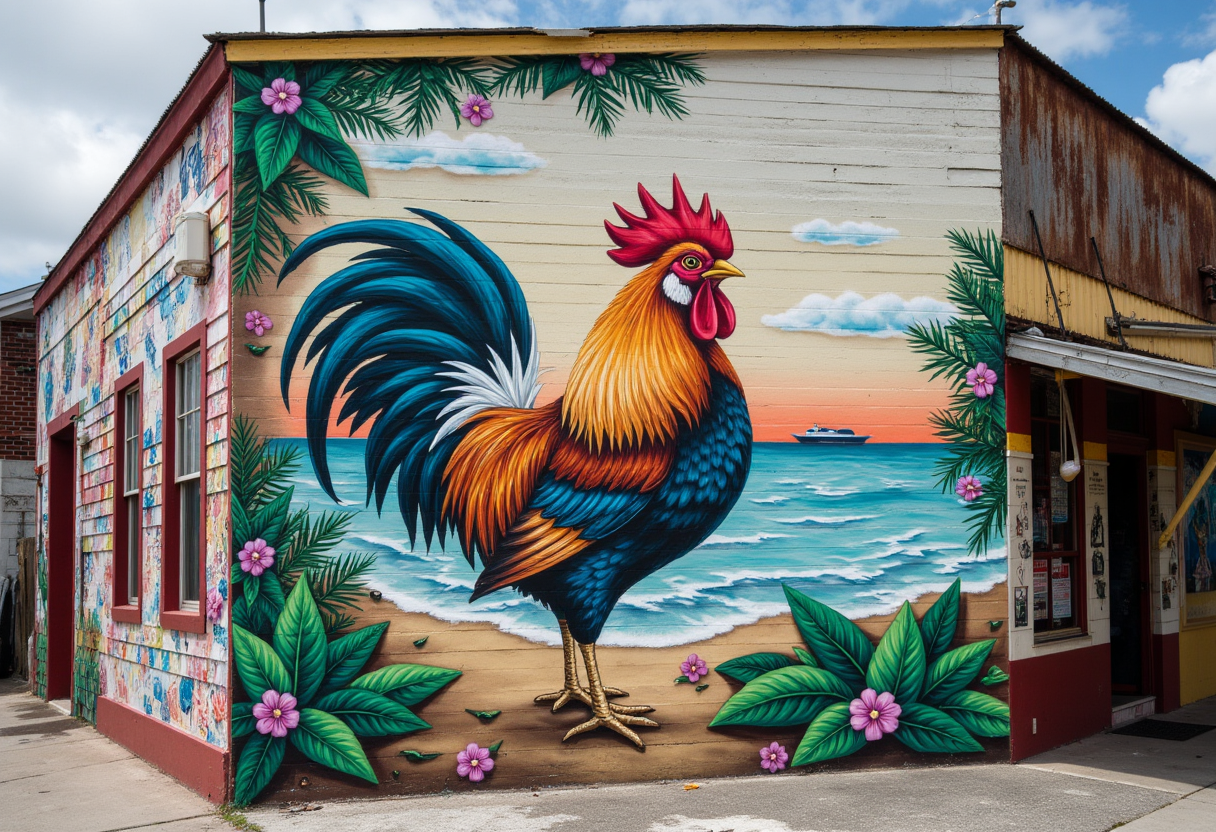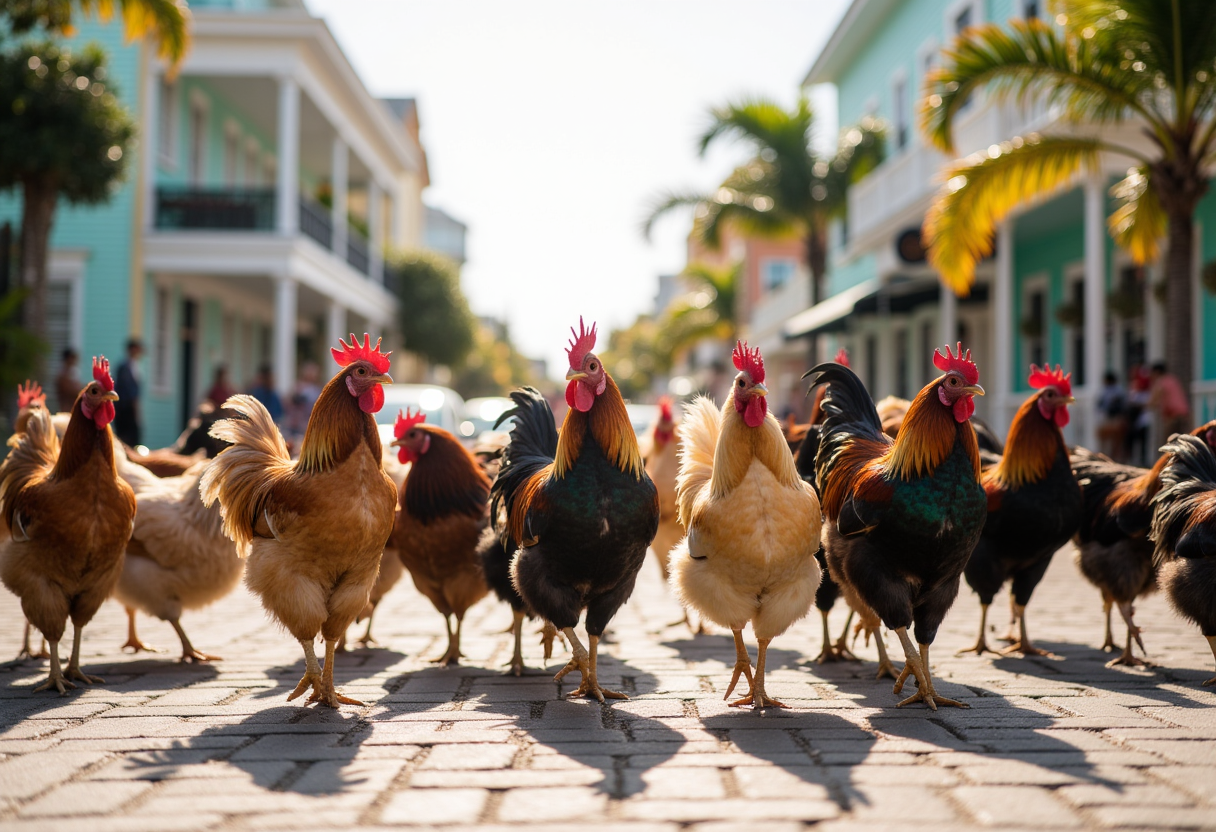Why the Chickens in Key West Think They Own the Place: A Poultry Paradise Unpacked
stylized mural of a majestic Key West chicken, specifically a rooster with a striking, defined comb and wattle, set against the backdrop of a colorful, weathered building wall in the heart of Key West.
Key West chickens don’t pay rent, obey traffic laws, or care about your schedule — and that’s exactly why they’ve become part of the island’s personality.
Stroll Duval Street in the Florida Keys and you’ll quickly learn who the real locals are: not the bartenders, artists, or retirees, but the roosters and hens strutting with perfect, unapologetic confidence.
They patrol sidewalks and café patios, peck at crumbs like shareholders conducting an audit, and yes — the roosters crow at all hours, from pre-dawn to unexpected mid-afternoon reminders that the day is still young.
This isn’t just a quirky anecdote — Key West’s free-ranging birds are woven into the island’s history and culture, and their presence shapes the streets, the local food scene, and the stories people tell when they visit.
Curious how a tiny island became a poultry paradise?
Below, we unpack the history, the laws that protect them, and practical tips for visitors who want to enjoy (but not disturb) Key West’s feathered residents.
A Brief History of Bird Takeover: From Dinner Plate to Diplomatic Immunity
Key West chickens weren’t always the island’s unofficial mascots — they started as practical livestock. Early settlers and residents across the Florida Keys kept chickens for eggs, meat, and feathers long before tourism turned the Keys into a vacation brand.
As communities grew, Cuban immigrants brought cultural traditions — including cockfighting in the 19th century — that elevated certain roosters into prized animals rather than mere food
Over time these birds gained social value: names, reputations, and, in some neighborhoods, a celebrity status.
When supermarkets and changing zoning rules made backyard farming less necessary, some owners released birds rather than maintain them. Those released flocks adapted quickly to island life and began to roam freely through neighborhoods and tourist corridors.
a diverse flock of chickens (featuring a mix of bright, sun-kissed roosters and hens with feathers in shades of iridescent blue, emerald green, and burnished copper) strolling nonchalantly across a busy street in the heart of Key West, Florida.
The modern distribution of Key West’s chickens owes a lot to nature as well. Hurricane Georges in 1998 displaced many animals across the Keys — surviving chickens found new pockets of habitat, and their numbers spread as they reproduced in predator-light, food-rich streets and yards.
Put simply: these birds survived, adapted, and multiplied. That combination — historical presence, cultural significance, and opportunistic resilience — is why Key West chickens are now an enduring and visible part of island life.
Protected, Pampered, and Practically Royal: The Avian Aristocracy of Key West
Here’s the surprising part: Key West chickens have more than local tolerance — they have legal recognition. Local ordinances acknowledge the role these birds play in the city’s character and culture, which affects how officials and residents manage the chicken population.
Ordinance 04-13 and related city code language treat roaming chickens as part of Key West’s historic and cultural fabric (confirm exact wording with the City of Key West code). That classification means harming or willfully removing birds can carry legal consequences — a factor that shapes policy and public sentiment.
Because of that protection, efforts to control numbers have to balance animal-welfare rules, resident concerns, and community values.
In the past the city even experimented with hiring a “chicken catcher” to reduce flocks, but the role proved politically sensitive and short-lived as locals pushed back.
Today, relocation and humane management programs still exist in various forms, usually moving birds to less-touristed, more rural parts of the Keys when necessary. Those programs are handled carefully because many residents view the birds as part of Key West’s identity — beloved, tolerated, and occasionally begrudgingly defended.
How the law affects visitors and residents:
Do not harm or harass chickens — city protections can make that a misdemeanor.
If you find an injured bird, contact local animal control or a humane rescue organization rather than attempting removal yourself.
Avoid feeding roaming flocks — feeding encourages larger, more concentrated groups in tourist areas.
The upshot: Key West chickens are part of the island’s wildlife and cultural scene. Management requires coordination between the city commission, animal-welfare groups, and residents — all while honoring the quirky, free-range spirit that makes the island unique.
a colorful and vibrant souvenir shop window display that showcases the unique charm of Key West, Florida, with a focus on its beloved island icons, the Key West chickens.
Not Everyone’s Clucking Happy: The Feathered Follies and Human Foibles
A robust population of free‑range chickens brings character — and headaches. While many celebrate the quirky charm of Key West’s roosters and hens, others deal with daily nuisances that range from garden damage to persistent crowing.
For homeowners, intentional or not, chickens can turn manicured yards into dug‑up plots. They’re prolific droppers, too — porches, sidewalks, and parked cars can become unintended canvases for avian art.
And the crowing? Some roosters crow at odd hours, making quiet mornings a rarer commodity for residents and visitors alike.
Locals have gotten creative with humane deterrents: motion‑sensor sprinklers, gentle water sprays, and signage asking tourists not to feed the birds. These tactics aim to discourage concentrated flocks in touristy streets while keeping the animals safe.
Practical tips residents and visitors use:
Do not feed roaming chickens — feeding increases flock size in busy areas and creates sanitation issues.
Use humane deterrents (sprinklers, covered compost, motion lights) rather than harmful methods.
Report injured birds to local animal control or a wildlife rescue group instead of attempting capture yourself.
Even with frustrations, many residents admit a grudging respect for these birds. You’ll see them navigate intersections with surprising savvy, seek the best happy‑hour crumbs, and know precisely when a tourist is lining up a selfie.
In short: they’re clever, opportunistic, and thoroughly integrated into Key West street life.
Icons of the Island: From Roaming Roosters to Cultural Curiosities
Key West chickens are more than backyard birds — they’re woven into the island’s identity. You’ll see their images on postcards, T‑shirts, and vibrant murals that brighten alleyways across the keys.
Local artists celebrate roosters and hens in galleries not devoted to Hemingway or sunsets; entire shows sometimes center on feathered subjects rendered in day‑glo colors or playful caricature.
Their likenesses are sold as souvenirs and showcased in public art, reinforcing the chickens’ place in Key West culture.
There are informal Chicken Coop Tours and chicken‑spotting walks you can join (many organized by local guides or artists) — though “schedule” is a suggestion, since the birds prefer to roam freely.
Seeing a rooster strut past the Southernmost Point Buoy or pose for a Mallory Square sunset snap is now a staple Key West photo op.
Where to see them: Duval Street and nearby residential blocks, side streets around Mallory Square, and many alleyways near popular galleries — prime spots for a true Key West encounter.
If you’re planning to visit Key West to photograph the birds, a quick checklist helps: respect signage, don’t feed flocks, keep a safe distance, and watch for traffic. These simple steps keep both people and chickens safe while preserving the island’s quirky, free‑range charm.
Key West is, at its heart, a town that celebrates the offbeat, the eccentric, and the wonderfully weird — and its chickens fit right in.
These birds aren’t merely surviving in this quirky ecosystem; they’re thriving. Roosters and hens have carved out a niche so unmistakably Key West that imagining the island without them feels like picturing a sunset without the green flash: noticeably less magical.
They’re a living example of adaptation and resilience — free‑range, opportunistic, and unapologetically themselves. Yes, they can be noisy and messy, but that same audacity is part of what makes Key West’s streets and neighborhoods memorable to visitors and locals alike.
If you’re planning to visit Key West to see the famous roosters, keep these simple guidelines in mind:
Do not feed the chickens — feeding encourages larger groups in tourist areas and creates sanitation problems.
Maintain a respectful distance when photographing; sudden movements can startle birds and people.
Report injured or ill birds to local animal control or a wildlife rescue organization rather than attempting to handle them yourself.
So next time a rooster crows at midnight or a hen strides across a crosswalk, don’t panic — it’s just the island’s most charismatic residents doing their rounds.
Enjoy the show, respect the rules, and you’ll leave with a better story (and better photos) than most tourists. Thanks for reading — Florida Unwritten Staff
Earl Lee
Florida Unwritten Staff



